|
FAQs about Marine Snail
Identification 26
Related Articles: Gastropods, Sea Slugs, Mollusks, Abalone,
Related FAQs: Snail ID
1, Snail ID 2, Snail ID 3, Snail
ID 4, Snail ID 5, Snail ID 6, Snail
ID 7, Snail ID 8, Snail ID 9, Snail ID
10, Snail ID 11, Snail ID 12, Snail
ID 13, Snail ID 14, Snail ID 15, Snail ID
16, Snail ID 17, Snail ID 18, Snail ID
19, Snail ID 20, Snail ID 21, Snail
ID 22, Snail ID 23, Snail ID 24, Snail
ID 25,
Snail ID 27, Snail
ID 28, Snail ID 29,
Snail ID 30,
& Marine Snails
1, Marine Snails
2, Marine Snails 3,
Invertebrate ID, Snail Behavior, Snail Selection, Snail Compatibility, Snail Systems, Snail Feeding, Snail Disease, Snail Reproduction, Mollusks, Sea
Slugs, Abalone,
|
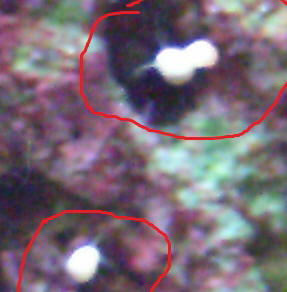
|
|
Shell IDs, Maine 10/3/12
Charlotte wanted to know about what kind of shells/snails she
collected... can you help?
<Aye, periwinkles. B>
|
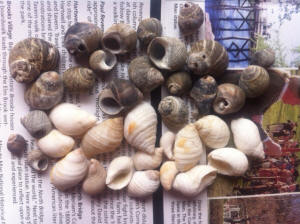 |
|
Lynn, does this look like a cowry to you? B 10/2/12
<Yep, it sure does. I'll gladly take a stab at an ID if
Wei can get some good close-up photos of the cowry when its mantle is
retracted and not obscuring the shell. Also, I'd need to know the
size. Take care, Lynn Z> 10/2/12
Wei, can/would you send along a better resolved, close-up pic or two?
BobF 10/2/12
Hitchhiker Snail ID / Fuzzy, Oval Snail with proboscis
Hello WWM Crew!
I had the pleasure of seeing Bob speak this weekend at MACNA.
Definitely an insightful and fascinating talk.
We encountered this snail-like hitchhiker while acclimating our corals
from MACNA for quarantine. It is dark colored and oval with a
proboscis. The unusual aspect are the pale fringe like fuzz that
covers the entire shell when the snail is active. The fuzz
disappears when the snail is in its shell -- the fuzz gives it a fuzzy
Chiton-like appearance, but doesn't have the requisite segments. I
also haven't seen the proboscis in pictures of Chitons I've looked at.
It is about half an inch ling and about a quarter of an inch wide. It is
fairly fast - I would say it is comparable to a Trochus in speed.
I've attached a picture for your reference. Please let me know if
you'd like me to send more photos. Would definitely appreciate
your insight on what it is and whether we should be wary..
Thanks so much!
Wei
|
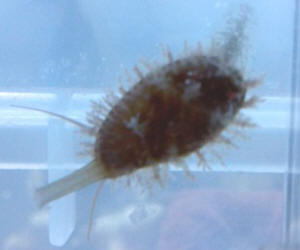 |
|
Re: Hitchhiker Snail ID / Fuzzy, Oval Snail with proboscis:
Cowry – 10/2/12
Hey Bob,
<Sorry Wei, Lynn here this afternoon (but I’ll pass this along to him).>
Absolutely! I've attached two full resolution shots that seem to be
better lit than the initial one.. Let me know if these help.
<They do, thanks! Your little hitchhiker is most likely a cowry of some
sort. The branched, soft tissue covering the shell is the snail’s mantle.
I’d be happy to pursue this further in hopes of identifying which species
you have, but I’d need a couple of photos of the shell itself (without the
obscuring mantle). Also, if you could tell me the size of the shell,
that would be super. In the meantime, here are several links for more
information/comparison:
http://www.wetwebmedia.com/gastropo.htm
http://liveseashells.seashell-collector.com/browse/Cypraeidae >
Thanks again for the wonder work you do - it was great to finally see you
talk in person after all these years of reading your work and insight
virtually.
Talk soon,
Wei
<Take care, Lynn Z>
|
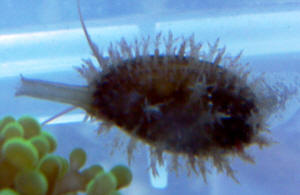
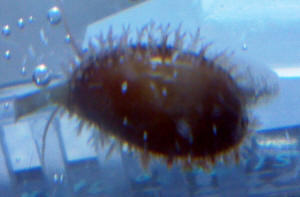 |
|
Snail I.D. 9/6/12
Hi folks,
<Hi Richard>
once again I turn to the experts with a question. I have tried to figure
out the exact type of snail in this picture but without any luck.
While they seem to do a good job as a clean up crew, they have
reproduced in such numbers as to be almost scary. They came aboard as
hitchhikers, and are now in the literal thousands. They cover the tank
walls and most of the live rock during night time hours. Should I allow
them all to stay or should I try to "thin" the herd a bit? They
never get any larger than an English Pea.
<Looks to be a Collonista sp, likely C. amakusaensis. Beneficial algae
grazers. There are a number of Wrasse that will gladly eat them. Manual
removal is up to you but there numbers will likely return given proper
food supply or lack of predators. They will never grow to any size and
there small shells can clog up pump intakes.>
Thank
<Quite welcome.>
Richard
<Jordan>
Snail I.D. 9/6/12
Hi folks, once again I turn to the experts with a question. I have tried
to figure out the exact type of snail in this picture but without any
luck.
While they seem to do a good job as a clean up crew, they have
reproduced in such numbers as to be almost scary. They came aboard as
hitchhikers, and are now in the literal thousands. They cover the tank
walls and most of the live rock during night time hours. Should I allow
them all to stay or should I try to "thin" the herd a bit?
<See email with image for response. Jordan>
Thank
Richard
|
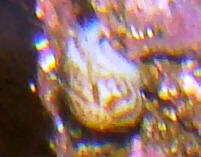 |
|
Conch or Cone Shell? Strawberry Conch: Conomurex
luhuanus - 8/17/12
Hi Rob,
<Hi Chris, Lynn here today.>
The guy at the store claimed that this was a conch. I'm not so sure.
Check out these photos (taken with my phone so maybe a bit blurry) and
let me know what you think. Currently using tongs to handle it just to
be on the safe side.
<Better safe than sorry! Thankfully, what you have is a beautiful little
Conch called Conomurex luhuanus (synonym: Strombus luhuanus) in the
family Strombidae, commonly known as the Strawberry
Conch. The overall shape of the snail, with relatively straight
sides and a short spire on top, makes it easy to misidentify as a
species of Cone snail (family Conidae). What gives it away as a
true Conch is the “stromboid notch”, or small indentation, that’s
located on the lip of the shell, towards the anterior end. This is
where one of the eyestalks protrudes when the animal is cruising about,
foraging for micro and macro-algae. The notch can vary from slight
to pronounced, but in your snail, it’s the latter! Also
differentiating Strombids from conids is the way each moves. While
Strombids tend to lurch and “leap” across the sand, giving the animal a
somewhat ungainly appearance, conids tend to slide or glide.
Another helpful differentiation involves the eyes. Strombids tend
to have obvious, almost knob-like eyes on the ends of long stalks while
conids’ eyes typically appear as little more than black dots on the tips
of tapered stalks.
In the wild, Conomurex luhuanus inhabits areas of open sand, seagrass
beds, and coral rubble in the Western Pacific and ranges from 2-3 inches
(50-80mm) in shell length. As juveniles, they tend to bury
themselves in soft sand, either partially or fully, so don’t be too
surprised if your individual disappears for a bit under the substrate.
As far as care goes, these snails are harmless, beneficial herbivores
with big appetites for micro and macro-algae, so if the supply starts to
run low in your system, you might want to try offering it some Nori
that’s been rubber-banded to a rock on the sandbed. You should be
able to find dried, packaged Nori at the grocery store in the Asian
section (used for sushi). Also, make sure that the rubber-band is
a new one – not one from the newspaper! Please see the following
links for photo comparison:
http://www.gastropods.com/5/Shell_205.shtml
http://www.poppe-images.com/?t=33&search=conomurex+luhuanus >
Thanks,
<You’re very welcome.>
Chris
<Take care, Lynn Z>
Re Conch or Cone Shell Part 2: Strawberry Conch: Conomurex
luhuanus - 8/17/12
Hello again,
<Hello Chris, Lynn here again.>
I dug up some info:
"There is, however, a surefire way of discerning whether you have a real
conch. When the animal extends from its shell, look closely at its eyes.
In all of the animals in this group, the eyes are large and evident,
located at the end of a long stalk, and they possess an evident eyeball
with a visible pupil. They are visually oriented animals and will watch
you."
-R. Shimek, The Grazing Snails, Part III: Conchs, Ceriths, Cowries, and
Columbellids
In the photograph with the unidentified creature on its back you can
clearly see its eyes. I wonder if that fits the above description?
<Yep, it sure does. As mentioned in the last message, there’s a
definite difference between Strombid and Conid eyes. Strombid eyes
are much more obvious and recognizable. Here are some photo links
for comparison:
Conomurex luhuanus:
http://www.poppe-images.com/?t=17&photoid=924709
Conus species (black dots on the end of white tapered stalks):
http://www.divegallery.com/cone_venomous.htm >
Chris
<Take care, Lynn Z>
|
.JPG)
.JPG) |
|
Snail or Conch? Likely Columbellid Snails and Spirorbids -
4/17/12
Hi Crew,
<Hello Dave, Lynn here this evening.>
We've had an explosion of births of some kind of snail or conch in both of
our salt water tanks. It happened several weeks ago and the little critters
are now about the size of elbow macaroni (sorry, I couldn't think of a
better comparison!). Anyway, I did quite a bit of reading here on WWM
and have looked at quite a few photos but I'm still not convinced of what
they might be. I attached a photo showing two of them hanging out on
some live rock together. They look like they have a proboscis. Their shells
are growing as they grow.
<The snails appear to be harmless/beneficial Columbellids (family
Columbellidae), aka “Dove” snails that feed on film algae, possibly diatoms,
and tend to be prolific breeders. For more information, please see the
following link:
http://wetwebmediaforum.com/showthread.php?336-Critter-of-the-Week-Columbellid-snails&highlight=columbellid
>
I guess the reason I'm worrying a little bit is because I've read that some
species of conch are not good to keep with other invertebrates and are
carnivorous. We do have several Fighting Conch but they are very
peaceful and spend most of their time below the sand bed. Also, I'm
not sure if it's related, but we've also seen an explosion of tiny white
circular crusty adhesions, about the size of a pinhead,
<No worries, those are tiny, harmless, filter-feeding, feather dusters
called Spirorbids.>
…stuck to the glass and all of the structures. They are everywhere.
<This is typical, especially in new systems. Eventually, the
population will taper off to a more manageable level but in the meantime,
you can remove any unwanted individuals from the glass with a scraper (an
old credit card works well for this).>
I included a photo of an artificial leaf from one of our tanks showing them.
Are these egg packets or something? Or is this some form of algae?
<Nope, they’re Spirorbids. If you take a close look, you can see the
feathery feeding appendage on some of the individuals in your photo.
For more information/photos, please see the following links:
http://www.wetwebmedia.com/feather.htm
http://www.sms.si.edu/irlspec/spirorbis_spp.htm >
Thanks, as always, for your help and insight.
<You’re very welcome.>
Things are going quite well in our tanks right now because of your past
guidance.
<Thanks, that’s great to hear/read.>
There is no better feeling than stable fish tanks.
<That’s way up there on the list for sure!>
DaveZ
<Take care, Lynn Z>
|
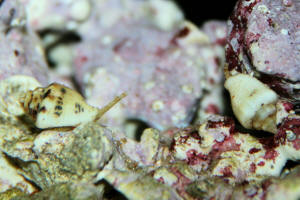
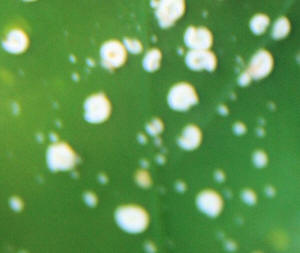 |
|
ID Please. Think I know what it is – Cone
Snail. Possible Whelk – 2/28/12
Hello Bob and Crew!
<Hello Mike, Lynn here today. What’s up?>
Was looking at new corals just in from Australia yesterday
<Beautiful!>
…and noticed his feeler out. He came from under a
chalice!!!!
<Sneaky snail!>
Only his shell is a little more on the black side from photos
I
<Is there some text missing here? No worries, the snail
does not appear to be a cone snail, but instead possibly a Whelk
(Superfamily: Buccinoidea), Strombus (Superfamily: Strombidae,
Family Strombidae), or Murex (Superfamily Muricoidea) of some
sort. That covers an awful lot of ground!
Unfortunately, I can’t see enough detail to narrow the ID
further or tell you with any certainty whether the snail poses a
threat to your livestock. It could be a carnivorous
predator and/or scavenger, or something similar to a Columbellid
(Superfamily Buccinoidea, Family Columbellidae) that grazes on
micro-algae. I would test this snail by offering a meaty bit
(shrimp/fish/clam, etc.) and see how it reacts. If it takes
the bait, and you choose to keep it as a scavenger, do keep it
well-fed, watch for damage to livestock, and remove if/when
necessary. Please see the following links for examples of
the above-mentioned groups:
Superfamily Buccinoidea:
http://www.gastropods.com/Taxon_pages/SuperFamily_BUCCINOIDEA.shtml
Family Strombidae:
http://www.gastropods.com/Taxon_pages/TN_Family_STROMBIDAE.shtml
Superfamily Muricoidea:
http://www.gastropods.com/Taxon_pages/SuperFamily_MURICOIDEA.shtml
Also, do please check Bob’s article/photos at the following
link, as well as the related links/FAQ’s at the top of the
page: http://www.wetwebmedia.com/gastroart2.htm >
Thanks!
<You’re very welcome!>
Mike Snyder
<Take care, Lynn Z>
www.thecoralshop.com
|
|
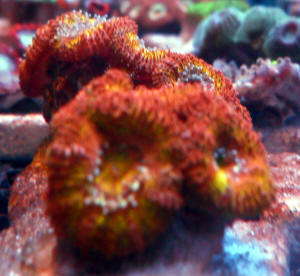 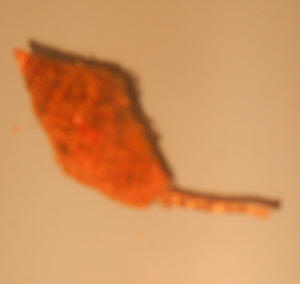
|
|
Snail ID 12/9/11
Hello, I have been keeping, for 10 years now, a 75 gal marine
tank that living things appear in from time to time. In general I
think it's cool to find these animals and macro algae, and
let them live.
However, I just noticed a couple snails at night on the glass and
also I found 5 of them in the overflow. I have included pictures
below.
(Sorry about the poor quality.) They have kind of a trunk that
they appear to use to find their way and the largest is maybe 1/2
inch long. Can you tell from these pictures if these are
predatory?
<Mmm, yes>
And should I catch and get rid of them?
<Depends... on what all else you have. Obviously these are
eating something>
I have a snowflake eel, Picasso trigger, and a yellow tail blue
damsel that I would hate to see harmed by these snails.
Thank You in advance,
Jack
<Look to me to be a type of Tulip Snail, maybe Fasciolaria
tulipa
Bob Fenner>
|
|
.JPG) .JPG)
|
|
Snail -- Gemophos spp. Whelk: 9/20/11
Hello WWM Saviors!
<Hello Jeremiah, how may I help you today?>
I have been having some mysterious disappearances overnight in my
new office 2.5G Reef tank (button polyp and a lot of macro
algae). I've noticed this hitchhiker snail hiding during the
day, but he came out this afternoon so I could snap a picture. Is
it a Nassarius?
<It's a cousin of sorts -- a Whelk in the genus Gemophos
with what appears to be a harmless Collonista snail along for the
ride. Please see related FAQ's at the following link for more
information/photos: http://www.wetwebmedia.com/WhelkF.htm
Enter 'Gemophos' in our Google search engine at the
bottom of this link for more references:
http://www.wetwebmedia.com/Googlesearch.htm >
Predatory?
<Most definitely, these snails prey on sessile invertebrates
and other Gastropods.>
Should I remove?
<Definitely>
It is Florida LR (in case it helps ID).
<Thanks -- yep, this particular snail is a common stowaway on
live rock from Florida. I typically get one or several with every
shipment, so keep an eye out for others. It's a shame because
they're actually very pretty, but unfortunately, they can do
some damage to your snail population. By the way, these snails
would not be the culprits consuming/doing damage to your button
polyps or algae. Check your water parameters and keep an eye out,
especially at night, for any other possible culprits.>
Thanks, you guys/gals are awesome!
<Why thank you!>
Jeremiah
<Take care, Lynn Z>
|
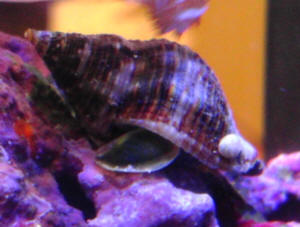 |
|
Snail ID Please 7/16/11
hello,
<Hello Anup>
Hope this email finds you in the best of times!!!
<As good as it gets.>
Could you please identify this snail species for me....these
snails are about 1cm long with a black shell and white spots on
it...they are always up and around gracing on the live rock and
glass panes of my reef aquarium...
<There are a gazillion different species of snails, but my
first guess would be a Bumblebee Snail. May want to look here
where you will find a few hundred species of snails with their
ID.
http://www.flickr.com/photos/wildsingapore/sets/72157600000717108/>
Thanks a lot
<You're welcome. James (Salty Dog)>
|
|
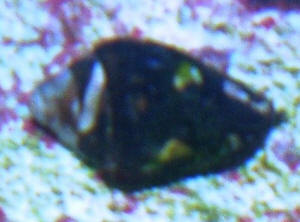
|
|
Re Snail ID Please 7/16/11
7/17/11
Dear James thanks a lot for the quick reply... The link you gave
me was very resourceful...gosh didn't know so many
existed...
<Thousands>
I found it going through the pics....Lightning dove snails
(Pictocolumbella ocellata) that's the one I am
having.....they have bred in my tank...many roaming my tank
....but they are tiny and unobtrusive... and hopefully reef safe?
right?
<I've asked Lynn, our resident gastropod expert, for her
comment re being reef safe. Her reply to me is below.>
<<Hi James,
Hmmm well, I still have no definitive answer. The general
consensus seems to be that they're most likely either
herbivores, or opportunistic omnivores that consume both algal
matter and other small critters like sponges, worms,
Ascidians/tunicates, 'pods/small crustaceans, etc. that they
come across while grazing. I'm 99% sure they're not
purely carnivorous predators. Personally, I'd judge them
innocent until proven guilty, but one thing I would definitely do
is test them by offering a bit of shrimp, fish, etc., to see how
they react. If they go for it, I'd either consider
removing/moving them, or keeping a sharper eye on them and
offering meaty bits (of marine origin) several times a week.
I'd also keep an eye on their numbers. If they're
opportunistic omnivores, and they're able to reproduce in
captivity (like the harmless herbivores Euplica scripta, Euplica
varians in the same family), their numbers can increase sharply.
If this happens, and their preferred food starts to run low, they
might begin to "sample" other items within the tank
(like other mollusks). Regarding reproduction, the querior may
notice clusters of clear, round, capsules containing a number of
white eggs deposited on tank walls. If they're like the
Euplica spp. mentioned above, the young develop within the
capsule until ready to crawl out and begin grazing (usually after
a couple of weeks). Hope that helps!
Take care,
-Lynn Z>>
Regards,
<And to you. James (Salty Dog)>
Anup Sadanandan
|
|
Can you ID this creature?
7/16/11
Let me preface by saying how wonderful you guys are! I own a reef
store in Las Vegas and tell everyone to check out the site.
<Ah, good to both>
I have a customer who brought me this cute little bug and would
like to know if he can keep him in his reef or not.
<Is a Limpet of some sort/species and should be fine w/ most
all one might have in a reef system>
His shell is hard and has the appearance of a scallop in shape
but it is more like a snail. In the second pic you can see his
little antenna sticking out from under his shell. Thanks in
advance.
<Please see here: http://wetwebmedia.com/LimpetID1.htm
and here: http://wetwebmedia.com/LimpetCompF.htm
Bob Fenner>
|
|
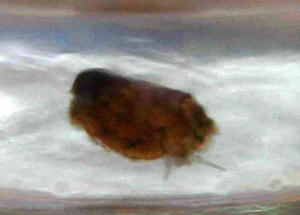 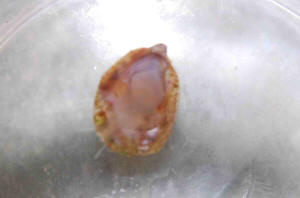
|
|
unknown snail ? 7/15/11
Hello to the crew,
<Howdy Rich>
One of the main problems with identifying unknowns is not knowing
what to search under, and running blind yields literally millions
of hits... so I'm hopeful that someone within the crew will
be able to point me in the right direction (please). This shelled
development of my tank was discovered during the recent tank
move. They appear to be only under the substrate (of course I
don't get a chance to night view for any length of time) and
measures about 1cm across at it's widest point. Sorry about
the quality of the side shot, but at least it's profile is
discernible. Any ideas of it's identity?
I thank you for your assistance,
Richard J.C.
<Mmm, would like to see the inside of the shell of a dead
specimen, but I think this may be a member of the Slipper Shells,
genus Crepidula, a calyptraeid. Bob Fenner>
|
|
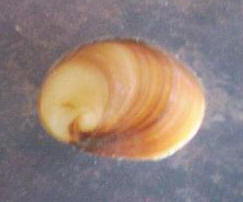 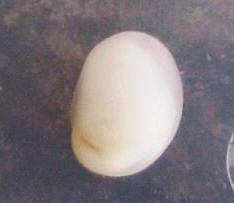
|
|
Please help... Nassarius or Whelks
7/3/2011
I have a 110 gallon tank with a 55 gallon tank as a sump. It is a
recent upgrade from a 75 gallon non drilled tank. but the system
has been running for about 8 years. The system seems to be
healthy, all water parameters are in check, tons of copepods
& amphipods are thriving. All corals have great polyp
extension and showing signs of growth. Other than finding a
couple dead hermits, everything else seems to be running
great.
<Ah, good>
I have recently purchased Nassarius snails for the tank about a
month - month and a half ago. I have included pictures of both
the larger snails that I purchased and a baby that I have seen 4
or 5 of in the last 2 days.
<... the larger snails are Nassarius obsoleta.( ILynassarius
obsoleta)>
The babies appear to have the same coloration and similar shape
as the grey and white striped one in the pictures. Their snout is
white in color but hard to see in the photos because they are so
small. Any help is appreciated. Thanks for taking the time to ID
these little guys.
I am hoping that you can tell me that my larger snails are in
fact Nassarius Snails, and if possible an ID on the babies would
be much appreciated.
<The smaller animals look like some sort of Whelk to me; and
too likely predaceous. I would remove them>
Thanks for your time and help.
Kimber
<Bob Fenner>
|
|
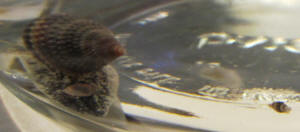 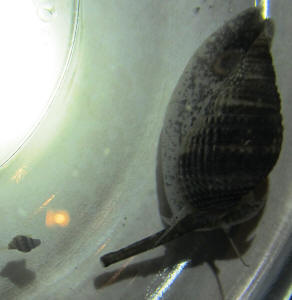
|
|
snail hitchhikers (WITH PICS) 5/1/11
Hello!
<Bri>
I just bought two pieces of soft coral and when I put them in my
tank (bobbing around the top in plastic bags) I noticed a very
large amount of small snails in the bag with the mushroom polyps,
perhaps 20 snails.
I carefully inspected the second bag (containing starburst
polyps) in a large glass bowl and found 2-3 snails. I picked the
snails off the starburst polyp and introduced it into the
aquarium. I'm afraid to open the mushrooms bag because of the
sheer amount of POSSIBLY dangerous snails (I could easily miss
one). I know they're not pyramid snails and they don't
look like the Sundial snail pictures on WWM. I searched all over
and didn't see any similar snails. The fish store said they
have seen them before but didn't know much about them and
didn't think they were a pest.
<I find this hard to believe>
If so many were in with the mushroom coral it made me think they
were "mushroom predators" maybe?
<See the Net re Heliacus snails period>
It also had a little anemone on the back of the rock which he
said wasn't Aiptasia after I found it at home. Since he
didn't know about the snails maybe he didn't know good
Aiptasia identification?
<Not Aiptasia; see WWM re Actinarian ID>
I'm attaching three photos to
possibly help.
Thank you,
Brian
<I'd be physically removing these snails, looking into
other control means... perhaps a Labrid... Bob Fenner>
|
|
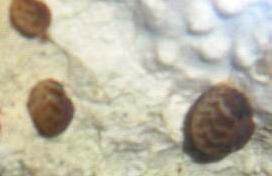 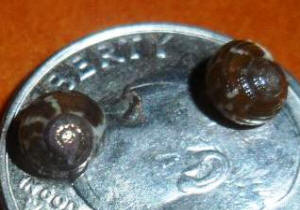
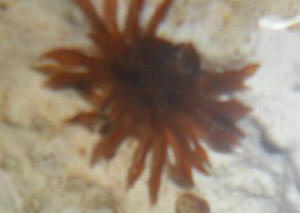
|
|
|

